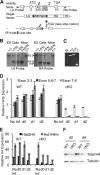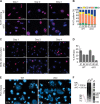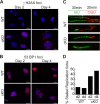Fidelity of histone gene regulation is obligatory for genome replication and stability
- PMID: 24797072
- PMCID: PMC4097655
- DOI: 10.1128/MCB.01567-13
Fidelity of histone gene regulation is obligatory for genome replication and stability
Abstract
Fidelity of chromatin organization is crucial for normal cell cycle progression, and perturbations in packaging of DNA may predispose to transformation. Histone H4 protein is the most highly conserved chromatin protein, required for nucleosome assembly, with multiple histone H4 gene copies encoding identical protein. There is a long-standing recognition of the linkage of histone gene expression and DNA replication. A fundamental and unresolved question is the mechanism that couples histone biosynthesis with DNA replication and fidelity of cell cycle control. Here, we conditionally ablated the obligatory histone H4 transcription factor HINFP to cause depletion of histone H4 in mammalian cells. Deregulation of histone H4 results in catastrophic cellular and molecular defects that lead to genomic instability. Histone H4 depletion increases nucleosome spacing, impedes DNA synthesis, alters chromosome complement, and creates replicative stress. Our study provides functional evidence that the tight coupling between DNA replication and histone synthesis is reciprocal.
Figures






Similar articles
-
p53 checkpoint ablation exacerbates the phenotype of Hinfp dependent histone H4 deficiency.Cell Cycle. 2015 Aug 3;14(15):2501-8. doi: 10.1080/15384101.2015.1049783. Epub 2015 Jun 1. Cell Cycle. 2015. PMID: 26030398 Free PMC article.
-
The Ddc1-Mec3-Rad17 sliding clamp regulates histone-histone chaperone interactions and DNA replication-coupled nucleosome assembly in budding yeast.J Biol Chem. 2014 Apr 11;289(15):10518-10529. doi: 10.1074/jbc.M114.552463. Epub 2014 Feb 25. J Biol Chem. 2014. PMID: 24573675 Free PMC article.
-
Maternal expression and early induction of histone gene transcription factor Hinfp sustains development in pre-implantation embryos.Dev Biol. 2016 Nov 15;419(2):311-320. doi: 10.1016/j.ydbio.2016.09.003. Epub 2016 Sep 5. Dev Biol. 2016. PMID: 27609454 Free PMC article.
-
Chromatin Replication and Histone Dynamics.Adv Exp Med Biol. 2017;1042:311-333. doi: 10.1007/978-981-10-6955-0_15. Adv Exp Med Biol. 2017. PMID: 29357065 Review.
-
All roads lead to chromatin: multiple pathways for histone deposition.Biochim Biophys Acta. 2013 Mar-Apr;1819(3-4):238-46. Biochim Biophys Acta. 2013. PMID: 24459726 Review.
Cited by
-
Histone availability as a strategy to control gene expression.RNA Biol. 2017 Mar 4;14(3):281-286. doi: 10.1080/15476286.2016.1189071. Epub 2016 May 21. RNA Biol. 2017. PMID: 27211514 Free PMC article. Review.
-
Promotion of Cell Viability and Histone Gene Expression by the Acetyltransferase Gcn5 and the Protein Phosphatase PP2A in Saccharomyces cerevisiae.Genetics. 2016 Aug;203(4):1693-707. doi: 10.1534/genetics.116.189506. Epub 2016 Jun 17. Genetics. 2016. PMID: 27317677 Free PMC article.
-
Higher order genomic organization and regulatory compartmentalization for cell cycle control at the G1/S-phase transition.J Cell Physiol. 2018 Oct;233(10):6406-6413. doi: 10.1002/jcp.26741. Epub 2018 May 10. J Cell Physiol. 2018. PMID: 29744889 Free PMC article. Review.
-
Regulation of Replication Fork Advance and Stability by Nucleosome Assembly.Genes (Basel). 2017 Jan 24;8(2):49. doi: 10.3390/genes8020049. Genes (Basel). 2017. PMID: 28125036 Free PMC article. Review.
-
Epigenetic-Mediated Regulation of Gene Expression for Biological Control and Cancer: Cell and Tissue Structure, Function, and Phenotype.Results Probl Cell Differ. 2022;70:339-373. doi: 10.1007/978-3-031-06573-6_12. Results Probl Cell Differ. 2022. PMID: 36348114 Free PMC article. Review.
References
-
- Wolffe A. 1995. Chromatin: structure and function. Academic Press, London, United Kingdom
-
- Stein GS. 1984. Histone genes: structure, organization, and regulation. John Wiley & Sons, New York, NY
Publication types
MeSH terms
Substances
Grants and funding
LinkOut - more resources
Full Text Sources
Other Literature Sources
Molecular Biology Databases
